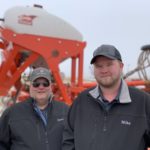2024 MWCG Schedule
Schedule
Schedule Overview
- 8:00 a.m. | Conference Registration & Exhibitors
- 8:50-9 a.m. | Welcome & Opening Remarks
- 9-10 a.m. | Plenary 1
- 10:15-11:15 a.m. | Plenary 2
- 11:15-11:50 a.m. | Networking
- Noon – 1:15 p.m. | Lunch & Exhibitors
- 1:15-2:15 p.m. | Breakout Session
- 2:30-3:30 p.m. | Breakout Session
- 3:30-3:45 p.m. | Closing Remarks
- 4:00 p.m. | Farmer Social at Pub 500
Plenary 1: 9-10 a.m.
Generating Added Value From Cover Crops
Cover crops provide many on-farm benefits, such as reducing soil erosion and building soil organic matter. That said, it’s also helpful to look at other ways cover crops contribute to the bottom line. In this session, Minnesota farmer Andy Linder will share how he adds value to cover crops by grazing cattle. He’ll also share his experiences with operating a cover crop seed business and providing custom cover cropping services.
Andy Linder
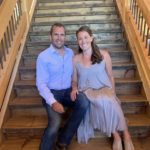 Andy Linder farms 1,200 acres near Easton, Minnesota, raising no-till soybeans, strip- and no-till corn, oats, canning crops and cover crops. He also operates a cover crop seed sales and custom application business. In 2017, Andy began custom grazing cattle as a way to diversify the row crop system. For six years, he has also custom-applied cover crops with a high-clearance seeder. Recently, he added a no-till drill and vertical tillage-seeder to offer more methods to custom-seed cover crops.
Andy Linder farms 1,200 acres near Easton, Minnesota, raising no-till soybeans, strip- and no-till corn, oats, canning crops and cover crops. He also operates a cover crop seed sales and custom application business. In 2017, Andy began custom grazing cattle as a way to diversify the row crop system. For six years, he has also custom-applied cover crops with a high-clearance seeder. Recently, he added a no-till drill and vertical tillage-seeder to offer more methods to custom-seed cover crops.
Plenary 2: 10:15-11:15 a.m.
Making a Comeback: Small Grains Back in Rotation
With a small-grains resurgence on the horizon in Minnesota, it’s valuable to learn from farmers about how small-grains crops fit into their operations. Learn from Byron, Minnesota, farmer Martin Larsen about his experiences growing these grains, the value they bring and why crops like oats and rye have become a staple in his rotations.
Martin Larsen
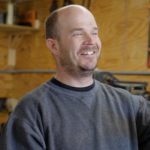 Martin Larsen is a fifth-generation farmer using no-till and cover cropping practices to grow conventional corn, soybeans, oats and rye near Byron, Minnesota. Martin also works for the Olmsted County Soil and Water Conservation District. He has done research on cover crops and nitrate reduction in local waterways and serves as president of the Minnesota Caving Club.
Martin Larsen is a fifth-generation farmer using no-till and cover cropping practices to grow conventional corn, soybeans, oats and rye near Byron, Minnesota. Martin also works for the Olmsted County Soil and Water Conservation District. He has done research on cover crops and nitrate reduction in local waterways and serves as president of the Minnesota Caving Club.
Breakout Session: 1:15-2:15 p.m.
Seeding and Grazing Summer Cover Crops After Small Grains
Do you have livestock? Are you looking to cover your soil after small grains? Hear from Eric Heins of Alutra, Minnesota, about how he seeds summer cover crops following his small grains for a summer of grazing. Learn about cover crop species selection, grazing methods and estimating manure credits for the next crop.
Eric Heins
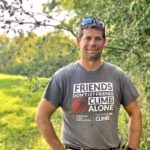 Eric Heins owns and operates Hoosier Ridge Ranch in Altura, Minnesota, alongside his wife Michelle. They grow small grains, canola, soybeans and hay. They also raise 100% grass-fed and grass-finished cattle along with pastured poultry that they sell directly to consumers. Eric and Michelle have worked to grow their grass-fed cattle operation alongside their custom grazing services by taking traditional row crop land, developing it into high-quality pastures and pairing it with cover crop grazing.
Eric Heins owns and operates Hoosier Ridge Ranch in Altura, Minnesota, alongside his wife Michelle. They grow small grains, canola, soybeans and hay. They also raise 100% grass-fed and grass-finished cattle along with pastured poultry that they sell directly to consumers. Eric and Michelle have worked to grow their grass-fed cattle operation alongside their custom grazing services by taking traditional row crop land, developing it into high-quality pastures and pairing it with cover crop grazing.
Nitrate Reduction With Cover Crops
Minimizing the loss of nitrates from fields into waterways is perhaps one of the most valuable benefits of cover crops. Curbing this loss helps retain nutrients where they are needed in the soil while improving water quality downstream. Martin Larsen has done research on this topic and will share what he’s learned about cover crops and nitrate reduction in local waterways.
Martin Larsen
 Martin Larsen is a fifth-generation farmer using no-till and cover cropping practices to grow conventional corn, soybeans, oats and rye near Byron, Minnesota. Martin also works for the Olmsted County Soil and Water Conservation District. He has done research on cover crops and nitrate reduction in local waterways, and serves as president of the Minnesota Caving Club.
Martin Larsen is a fifth-generation farmer using no-till and cover cropping practices to grow conventional corn, soybeans, oats and rye near Byron, Minnesota. Martin also works for the Olmsted County Soil and Water Conservation District. He has done research on cover crops and nitrate reduction in local waterways, and serves as president of the Minnesota Caving Club.
Breakout Session: 2:30-3:30 p.m.
Organic Grains From Field to Market
The Askegaard family operates an organic farm near Moorhead, Minnesota, where they grow small grains, oilseeds and legumes that they direct-market through local businesses. In this session, learn from Mark Askegaard and his daughter, Beth McConnon, about how their small grains, like flax and wheat, go from the field to local stores.
Mark Askegaard and Beth McConnon
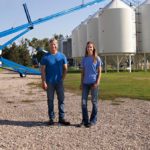 Mark Askegaard is a fifth-generation farmer at Askegaard Organic Farm who has a passion for preserving the land and promoting the health of communities through organic agriculture and local foods. He transitioned his family farm near Moorhead, Minnesota, to organic in 1995, with his primary crops being wheat, soybeans and flaxseed.
Mark Askegaard is a fifth-generation farmer at Askegaard Organic Farm who has a passion for preserving the land and promoting the health of communities through organic agriculture and local foods. He transitioned his family farm near Moorhead, Minnesota, to organic in 1995, with his primary crops being wheat, soybeans and flaxseed.
Beth McConnon is a sixth-generation farmer at Askegaard Organic Farm, where she manages the farm’s social media outlets and loves sharing her photography. She graduated from North Dakota State University in 2012 and is proud to work alongside her father promoting the local, organic food movement. She enjoys all aspects of her job – from working in the field to distributing products to local grocery stores.
Cover Crop Seeding Methods
In this session, Mike Unruh will share his experiences with three different cover crop seeding methods. Mike operates a cover crop seeding business and uses a VT air seeder and high precision spinner. In 2023, he also started interseeding cover crops using a drone. Learn from Mike about his experiences with each method.
Mike Unruh
Mike Unruh and his father, Dave, grow corn, soybeans, hay and cover crops on 600 acres near Winona, Minnesota, on the bluffs of the Mississippi River. They own Unruh Cover Cropping, which provides custom seeding using multiple methods in southeast Minnesota. They annually custom apply cover crops to between 2,500-4,500 acres. Mike also sells seed for Saddle Butte Ag and Dairyland Seed Co. and applies cover crops using a drone with AgriVision.

